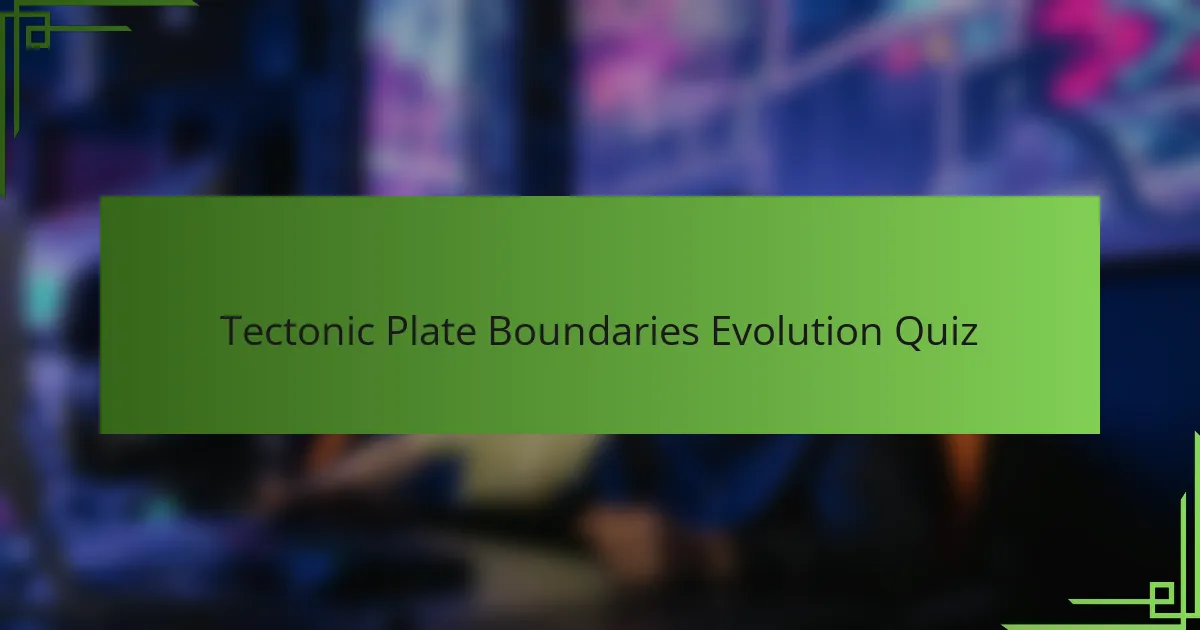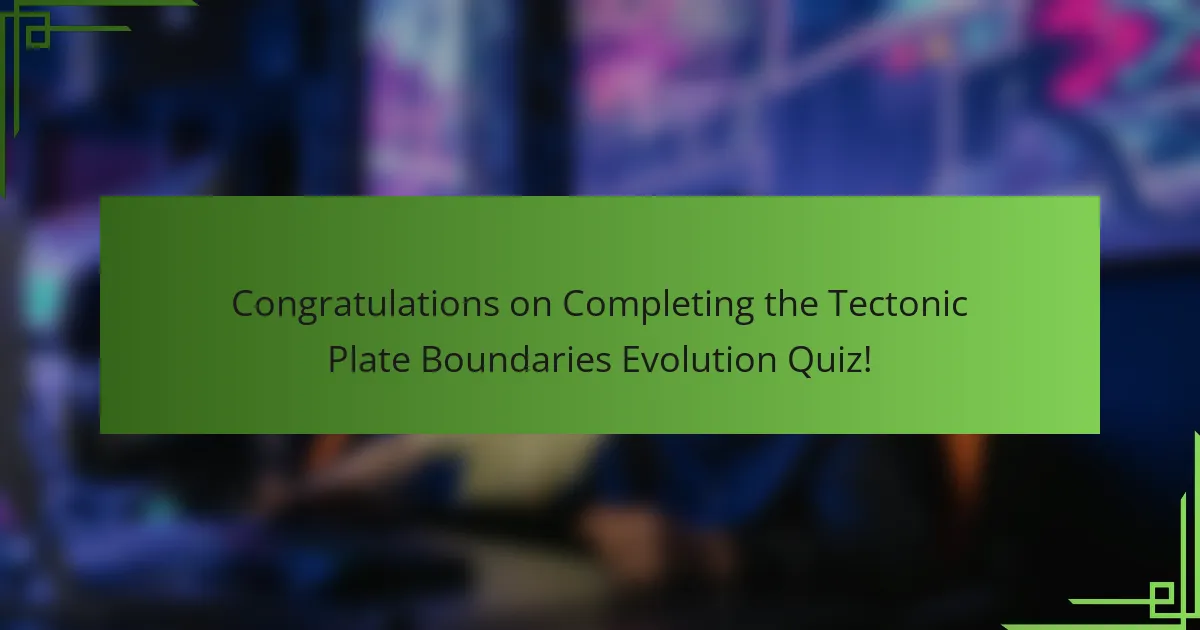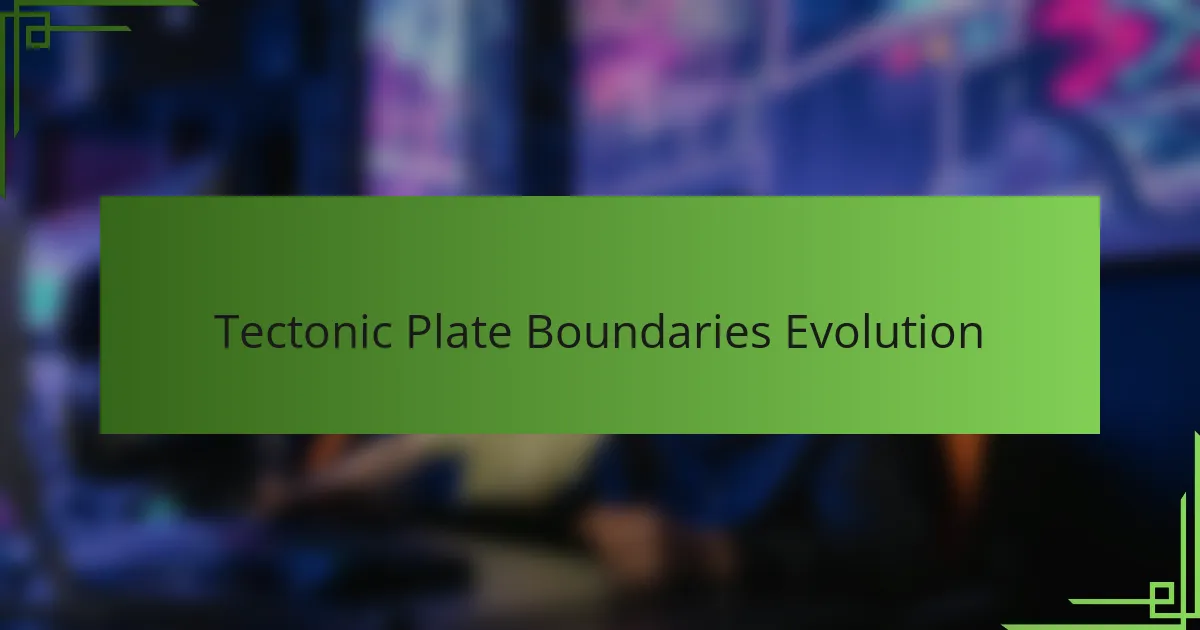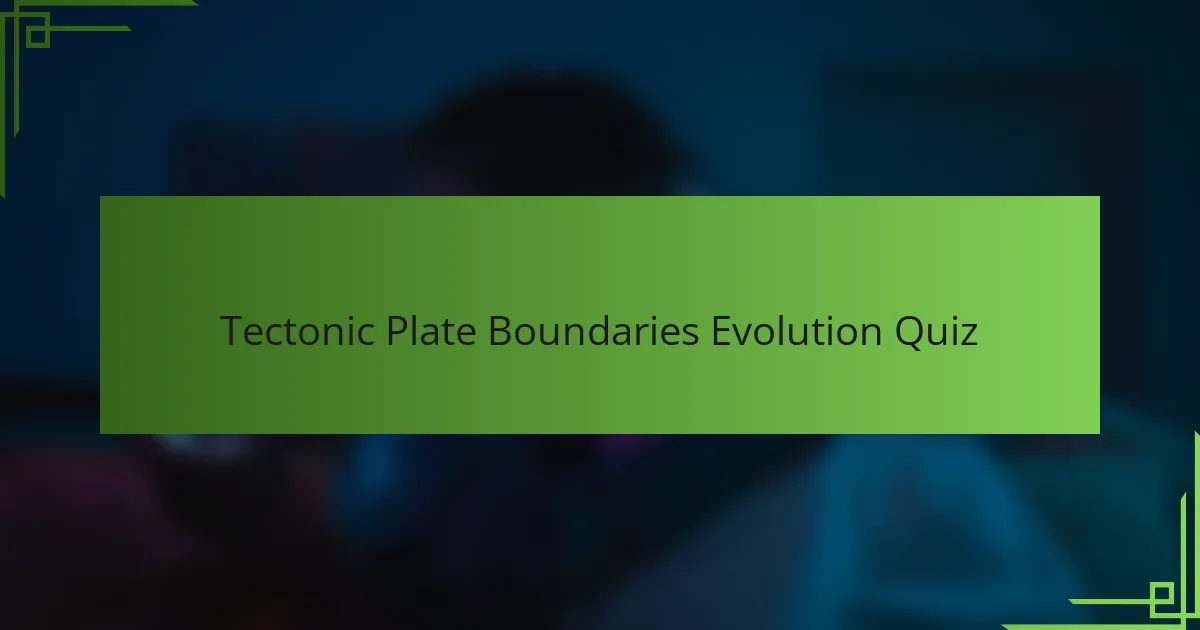
Tectonic Plate Boundaries Evolution Quiz
1. What type of tectonic plate boundary is responsible for the formation of the Mid-Atlantic Ridge?
- Convergent boundary
- Collision boundary
- Divergent boundary
- Transform boundary
2. Which tectonic plate boundary type is commonly associated with the Himalayas` formation?
- Transform plate boundary
- Divergent plate boundary
- Passive plate boundary
- Convergent plate boundary
3. The San Andreas Fault in California is an example of which kind of tectonic plate boundary?
- Convergent boundary
- Transform boundary
- Subduction zone
- Divergent boundary
4. Which tectonic plate boundary involves two plates moving away from each other, leading to sea-floor spreading?
- Subduction zone
- Convergent boundary
- Divergent boundary
- Transform boundary
5. The collision of the Indian Plate with the Eurasian Plate primarily illustrates what tectonic boundary process?
- Divergent plate boundary
- Transform plate boundary
- Passive plate margin
- Convergent plate boundary
6. What tectonic boundary is responsible for the volcanic activity along the Pacific Ring of Fire?
- Convergent plate boundaries
- Passive margins
- Divergent plate boundaries
- Transform plate boundaries
7. The Juan de Fuca Plate interacts with the North American Plate at what type of boundary?
- Convergent boundary
- Passive margin
- Transform boundary
- Divergent boundary
8. At which type of boundary do tectonic plates slide past each other horizontally?
- Convergent boundary
- Subduction zone
- Transform boundary
- Divergent boundary
9. Which tectonic plate boundary type is mainly linked to the creation of rift valleys like the East African Rift?
- Subduction zone
- Convergent boundary
- Transform boundary
- Divergent boundary
10. The Nazca Plate subducting beneath the South American Plate occurs at what type of boundary?
- Convergent plate boundary
- Transform plate boundary
- Passive plate boundary
- Divergent plate boundary
11. The formation and evolution of the Great Rift Valley is associated with which tectonic process?
- Transform fault movement
- Subduction zone formation
- Continental rifting
- Oceanic spreading ridge
12. Which plate boundary type typically results in the formation of oceanic trenches?
- Convergent plate boundary
- Passive plate boundary
- Transform plate boundary
- Divergent plate boundary
13. The movement between the Pacific Plate and the North American Plate along the San Andreas Fault is classified as what boundary type?
- Subduction zone
- Divergent boundary
- Transform boundary
- Convergent boundary
14. What type of plate boundary is exemplified by the divergent activity along the Red Sea?
- Transform boundary
- Subduction zone
- Convergent boundary
- Divergent boundary
15. Which tectonic boundary evolution explains the breakup of the supercontinent Pangaea?
- Subduction at convergent plate boundaries
- Collision at convergent plate boundaries
- Transform fault activity along strike-slip boundaries
- Rifting along divergent plate boundaries

Congratulations on Completing the Tectonic Plate Boundaries Evolution Quiz!
You’ve successfully navigated through the fascinating world of tectonic plate boundaries and their evolution. This quiz has highlighted how these massive plates interact, shift, and shape the Earth’s surface over millions of years. Understanding these concepts helps explain the formation of mountains, earthquakes, and volcanic activity—all fundamental to physical geography.
By engaging with this quiz, you’ve strengthened your grasp of key geographical processes. You’ve learned about different boundary types—divergent, convergent, and transform—and how they contribute to the dynamic nature of our planet. These insights deepen your appreciation for how Earth’s landscape is constantly changing and evolving.
For those eager to explore further, we invite you to visit the next section on this page. It offers detailed information and visual explanations on tectonic plate boundaries evolution. Expanding your knowledge here will enhance your understanding of geography’s role in shaping our world. Keep exploring and stay curious!

Tectonic Plate Boundaries Evolution
Overview of Tectonic Plate Boundaries
Tectonic plate boundaries are the edges where Earth’s lithospheric plates meet. These boundaries define interactions between plates and are categorized into three main types: divergent, convergent, and transform boundaries. The movement and interaction at these boundaries shape Earth’s surface and cause geological phenomena such as earthquakes and volcanic activity. The theory of plate tectonics, developed in the 20th century, provides the framework to understand these boundary interactions globally.
Formation and Evolution of Divergent Boundaries
Divergent boundaries form when tectonic plates move apart, creating a gap that allows magma to rise and form new crust. This process primarily occurs at mid-ocean ridges, like the Mid-Atlantic Ridge. Over time, this spreading leads to the widening of ocean basins. The continuous creation and outward movement of new lithosphere mark the evolution of these boundaries, influencing oceanic configuration and seafloor spreading rates.
Development of Convergent Plate Boundaries
Convergent boundaries occur when two tectonic plates move toward one another, often resulting in subduction or continental collision. Examples include the boundary between the Pacific Plate and the North American Plate along the Cascadia Subduction Zone, and the collision forming the Himalayan mountain range between the Indian and Eurasian Plates. These evolving interactions cause mountain building, volcanic arcs, and seismic activity due to the complex deformation of the crust at these zones.
Transform Boundaries and Their Geological Evolution
Transform boundaries exist where plates slide horizontally past each other. A well-known example is the San Andreas Fault between the Pacific Plate and the North American Plate. These boundaries evolve through lateral displacement and generate strike-slip earthquakes. The absence of crust creation or destruction characterizes these zones, yet they play a critical role in accommodating plate motions and linking segments of divergent and convergent boundaries.
Plate Boundary Reorganizations and Their Geological Significance
Plate boundaries are not static; they reorganize over geological time scales due to changes in mantle convection patterns and plate motions. An example is the evolution of the African Plate, which has seen the opening of the East African Rift as a new divergent boundary forming. Such reorganizations can lead to changes in earthquake distribution, volcanic activity, and continental configurations, significantly impacting Earth’s geological and environmental evolution.
What are tectonic plate boundaries?
Tectonic plate boundaries are the edges where two or more tectonic plates meet. These boundaries are classified into three main types: divergent, convergent, and transform. The movement and interaction of plates at these boundaries cause geological phenomena like earthquakes, volcanic activity, and mountain formation. The existence and classification of these boundaries are confirmed by global seismic data and the mapping of fault lines, such as the Mid-Atlantic Ridge for divergent boundaries and the Pacific Ring of Fire for convergent boundaries.
How do tectonic plate boundaries evolve over time?
Tectonic plate boundaries evolve through processes of plate movement driven by mantle convection, slab pull, and ridge push. Over millions of years, boundaries can shift, change type, or disappear as plates collide, separate, or slide past each other. For example, the Indian and Eurasian plates converged to form the Himalayan mountain range about 50 million years ago. Geological and geophysical evidence, including radiometric dating and plate motion measurements from satellite GPS, supports the gradual evolution of these boundaries.
Where are the most active tectonic plate boundaries located?
The most active tectonic plate boundaries are primarily found around the Pacific Ocean, known as the Ring of Fire. This includes subduction zones like the boundary between the Pacific Plate and the North American Plate, where frequent earthquakes and volcanic eruptions occur. Other active locations include the mid-ocean ridges such as the Mid-Atlantic Ridge and transform faults like the San Andreas Fault in California. Seismic records from global monitoring networks confirm these as high-activity zones.
When did the theory of tectonic plate boundaries become widely accepted?
The theory of tectonic plate boundaries became widely accepted in the late 1960s after the development of the plate tectonics model. This model unified previous concepts of continental drift and seafloor spreading. Key evidence came from paleomagnetic studies, mapping of the ocean floor, and global earthquake distribution. A pivotal moment was in 1967 when the Vine-Matthews-Morley hypothesis explained magnetic striping on the ocean floor, supporting seafloor spreading at divergent boundaries.
Who contributed significantly to the understanding of tectonic plate boundaries?
Key contributors to the understanding of tectonic plate boundaries include Alfred Wegener, who proposed continental drift in 1912; Harry Hess, who introduced seafloor spreading in the early 1960s; and J. Tuzo Wilson, who identified transform faults and contributed to the plate tectonics theory. Their work, supported by geological, geophysical, and oceanographic evidence, laid the foundation for the modern understanding of plate boundaries and their interactions.
